Conflict Management Report: Workplace Conflict Analysis and Solutions
VerifiedAdded on 2022/08/12
|9
|2065
|46
Report
AI Summary
This report delves into the multifaceted realm of conflict management within a workplace context, emphasizing the skills and performance aspects crucial for effective resolution. It begins by defining conflict and its causes, using a restaurant scenario to illustrate real-world implications. The report explores internal and external assistance methods for managing conflicts, such as workplace discussions and mediation, and analyzes the reasons behind conflicts, including misunderstandings and differing values. Furthermore, the report addresses strategies for mitigating the risk of conflict occurrence by implementing organized work environments, team meetings, and sufficient resource allocation. Section C focuses on performance-related activities, including the resolution of escalated customer complaints, addressing team member disputes such as roster conflicts and cultural misunderstandings, and identifying appropriate actions in response to various conflict situations like customer dissatisfaction and physical violence. The report provides practical solutions and management techniques to foster a positive and productive work environment, ultimately enhancing customer satisfaction and team performance.
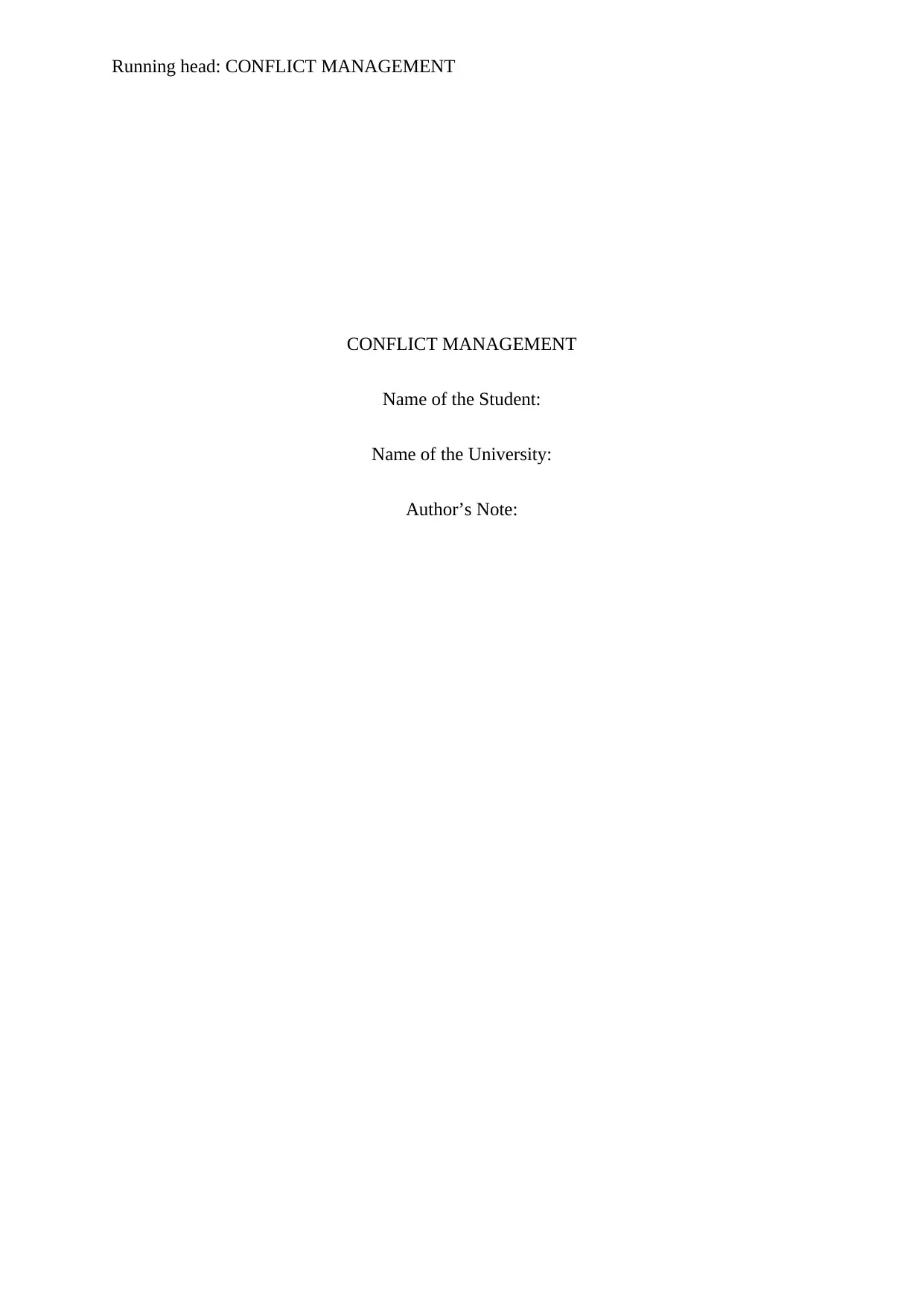
Running head: CONFLICT MANAGEMENT
CONFLICT MANAGEMENT
Name of the Student:
Name of the University:
Author’s Note:
CONFLICT MANAGEMENT
Name of the Student:
Name of the University:
Author’s Note:
Paraphrase This Document
Need a fresh take? Get an instant paraphrase of this document with our AI Paraphraser
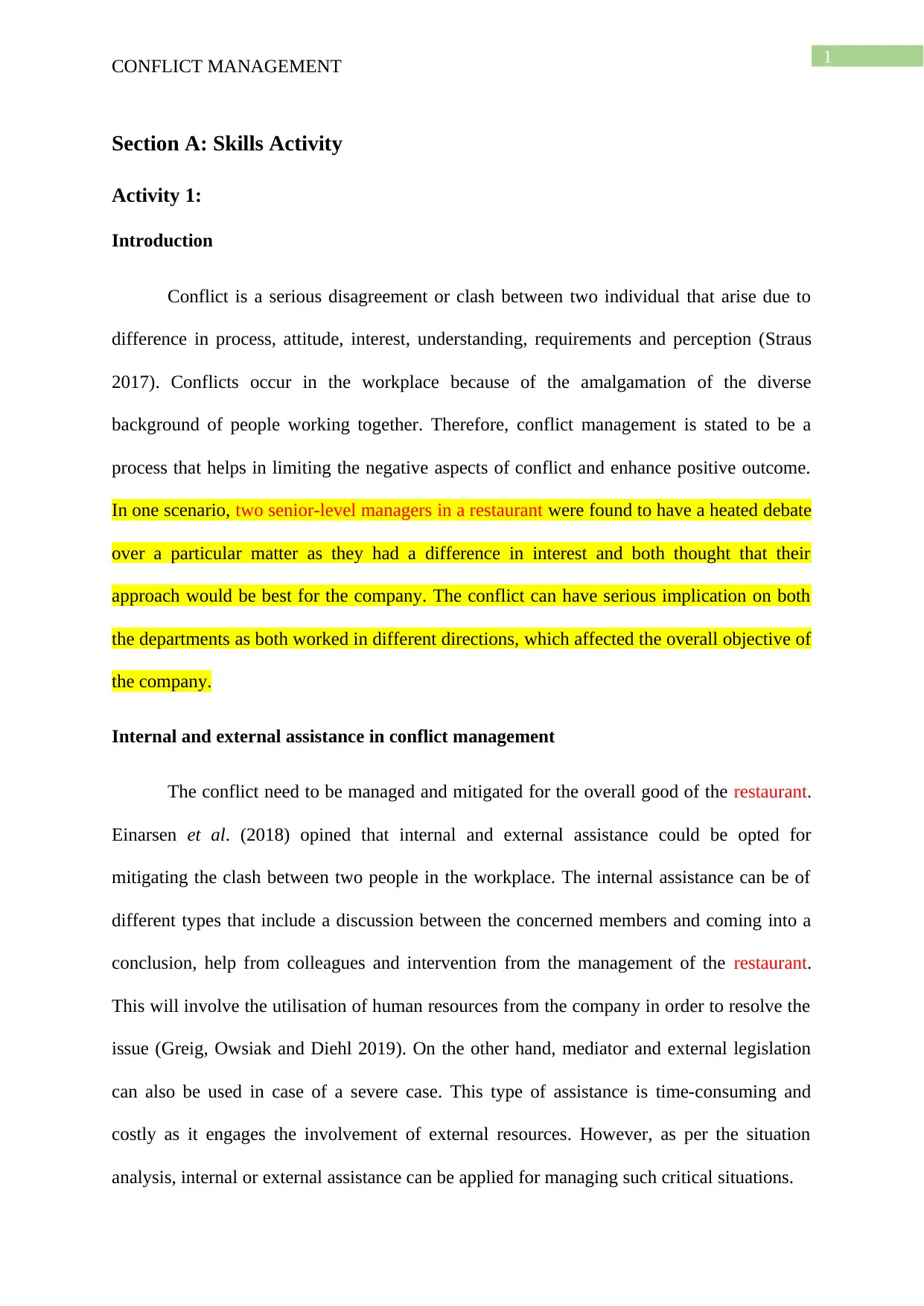
1
CONFLICT MANAGEMENT
Section A: Skills Activity
Activity 1:
Introduction
Conflict is a serious disagreement or clash between two individual that arise due to
difference in process, attitude, interest, understanding, requirements and perception (Straus
2017). Conflicts occur in the workplace because of the amalgamation of the diverse
background of people working together. Therefore, conflict management is stated to be a
process that helps in limiting the negative aspects of conflict and enhance positive outcome.
In one scenario, two senior-level managers in a restaurant were found to have a heated debate
over a particular matter as they had a difference in interest and both thought that their
approach would be best for the company. The conflict can have serious implication on both
the departments as both worked in different directions, which affected the overall objective of
the company.
Internal and external assistance in conflict management
The conflict need to be managed and mitigated for the overall good of the restaurant.
Einarsen et al. (2018) opined that internal and external assistance could be opted for
mitigating the clash between two people in the workplace. The internal assistance can be of
different types that include a discussion between the concerned members and coming into a
conclusion, help from colleagues and intervention from the management of the restaurant.
This will involve the utilisation of human resources from the company in order to resolve the
issue (Greig, Owsiak and Diehl 2019). On the other hand, mediator and external legislation
can also be used in case of a severe case. This type of assistance is time-consuming and
costly as it engages the involvement of external resources. However, as per the situation
analysis, internal or external assistance can be applied for managing such critical situations.
CONFLICT MANAGEMENT
Section A: Skills Activity
Activity 1:
Introduction
Conflict is a serious disagreement or clash between two individual that arise due to
difference in process, attitude, interest, understanding, requirements and perception (Straus
2017). Conflicts occur in the workplace because of the amalgamation of the diverse
background of people working together. Therefore, conflict management is stated to be a
process that helps in limiting the negative aspects of conflict and enhance positive outcome.
In one scenario, two senior-level managers in a restaurant were found to have a heated debate
over a particular matter as they had a difference in interest and both thought that their
approach would be best for the company. The conflict can have serious implication on both
the departments as both worked in different directions, which affected the overall objective of
the company.
Internal and external assistance in conflict management
The conflict need to be managed and mitigated for the overall good of the restaurant.
Einarsen et al. (2018) opined that internal and external assistance could be opted for
mitigating the clash between two people in the workplace. The internal assistance can be of
different types that include a discussion between the concerned members and coming into a
conclusion, help from colleagues and intervention from the management of the restaurant.
This will involve the utilisation of human resources from the company in order to resolve the
issue (Greig, Owsiak and Diehl 2019). On the other hand, mediator and external legislation
can also be used in case of a severe case. This type of assistance is time-consuming and
costly as it engages the involvement of external resources. However, as per the situation
analysis, internal or external assistance can be applied for managing such critical situations.

2
CONFLICT MANAGEMENT
Workplace discussion in resolution of conflict
One of the best possible strategies that can be used for mitigating the given scenario
between the two senior managers is workplace discussion. O'Sullivan (2017) opined that
workplace discussion involves discussing all the aspects related to the conflict within the
workplace for addressing the issue found in the conflict.
Conclusion
A discussion session was done between the two senior managers, along with a senior
of a restaurant. Both their perceptions were heard and the senior made them understand the
conflict is detrimental for the overall company. They were asked to resolve the issue by
discussing and come to a solution in the discussion session that employed internal assistance.
CONFLICT MANAGEMENT
Workplace discussion in resolution of conflict
One of the best possible strategies that can be used for mitigating the given scenario
between the two senior managers is workplace discussion. O'Sullivan (2017) opined that
workplace discussion involves discussing all the aspects related to the conflict within the
workplace for addressing the issue found in the conflict.
Conclusion
A discussion session was done between the two senior managers, along with a senior
of a restaurant. Both their perceptions were heard and the senior made them understand the
conflict is detrimental for the overall company. They were asked to resolve the issue by
discussing and come to a solution in the discussion session that employed internal assistance.
⊘ This is a preview!⊘
Do you want full access?
Subscribe today to unlock all pages.

Trusted by 1+ million students worldwide

3
CONFLICT MANAGEMENT
Activity 2:
Reasons for Conflict
A number of reasons are responsible for the development of conflicts. Kulkarni
(2019) opined that the most common reasons include misunderstanding, authority issue,
personal clash, lack of co-operation, competition for resources, low level of performance and
difference in value or goal. The conflict mentioned above that took place between two senior
managers was because of the difference in values opined by them. Both of them were
interested in enhancing the level of expectation of the company; however, they had a
different opinion. As a result of which, it hampered the overall performance of both the
groups in a restaurant.
Changes to limit the risk of occurrence
McGrory et al. (2017) opined that addressing the risk of occurrence of conflict in a
workplace is critical in nature. This is because it allows an efficient flow of work that will
ultimately lead to more productivity and high-performance level in a restaurant. The changes
that need to be implemented in limiting the risk of occurrence are to have an organised
working environment, opportunity of discussion, team meeting at regular interval for
discussion and sufficient supply of resources that help in minimising the negative impact of
conflict.
CONFLICT MANAGEMENT
Activity 2:
Reasons for Conflict
A number of reasons are responsible for the development of conflicts. Kulkarni
(2019) opined that the most common reasons include misunderstanding, authority issue,
personal clash, lack of co-operation, competition for resources, low level of performance and
difference in value or goal. The conflict mentioned above that took place between two senior
managers was because of the difference in values opined by them. Both of them were
interested in enhancing the level of expectation of the company; however, they had a
different opinion. As a result of which, it hampered the overall performance of both the
groups in a restaurant.
Changes to limit the risk of occurrence
McGrory et al. (2017) opined that addressing the risk of occurrence of conflict in a
workplace is critical in nature. This is because it allows an efficient flow of work that will
ultimately lead to more productivity and high-performance level in a restaurant. The changes
that need to be implemented in limiting the risk of occurrence are to have an organised
working environment, opportunity of discussion, team meeting at regular interval for
discussion and sufficient supply of resources that help in minimising the negative impact of
conflict.
Paraphrase This Document
Need a fresh take? Get an instant paraphrase of this document with our AI Paraphraser
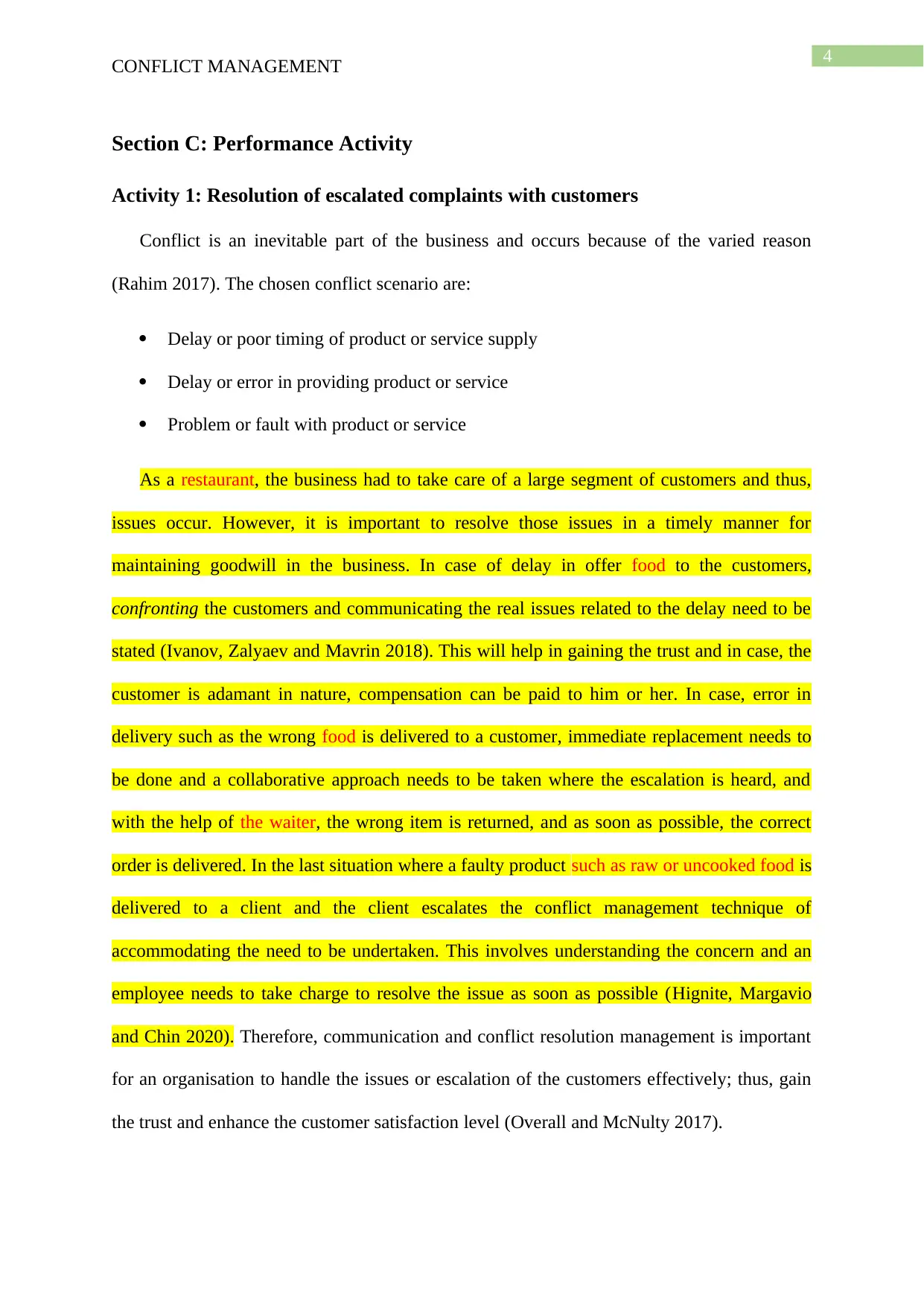
4
CONFLICT MANAGEMENT
Section C: Performance Activity
Activity 1: Resolution of escalated complaints with customers
Conflict is an inevitable part of the business and occurs because of the varied reason
(Rahim 2017). The chosen conflict scenario are:
Delay or poor timing of product or service supply
Delay or error in providing product or service
Problem or fault with product or service
As a restaurant, the business had to take care of a large segment of customers and thus,
issues occur. However, it is important to resolve those issues in a timely manner for
maintaining goodwill in the business. In case of delay in offer food to the customers,
confronting the customers and communicating the real issues related to the delay need to be
stated (Ivanov, Zalyaev and Mavrin 2018). This will help in gaining the trust and in case, the
customer is adamant in nature, compensation can be paid to him or her. In case, error in
delivery such as the wrong food is delivered to a customer, immediate replacement needs to
be done and a collaborative approach needs to be taken where the escalation is heard, and
with the help of the waiter, the wrong item is returned, and as soon as possible, the correct
order is delivered. In the last situation where a faulty product such as raw or uncooked food is
delivered to a client and the client escalates the conflict management technique of
accommodating the need to be undertaken. This involves understanding the concern and an
employee needs to take charge to resolve the issue as soon as possible (Hignite, Margavio
and Chin 2020). Therefore, communication and conflict resolution management is important
for an organisation to handle the issues or escalation of the customers effectively; thus, gain
the trust and enhance the customer satisfaction level (Overall and McNulty 2017).
CONFLICT MANAGEMENT
Section C: Performance Activity
Activity 1: Resolution of escalated complaints with customers
Conflict is an inevitable part of the business and occurs because of the varied reason
(Rahim 2017). The chosen conflict scenario are:
Delay or poor timing of product or service supply
Delay or error in providing product or service
Problem or fault with product or service
As a restaurant, the business had to take care of a large segment of customers and thus,
issues occur. However, it is important to resolve those issues in a timely manner for
maintaining goodwill in the business. In case of delay in offer food to the customers,
confronting the customers and communicating the real issues related to the delay need to be
stated (Ivanov, Zalyaev and Mavrin 2018). This will help in gaining the trust and in case, the
customer is adamant in nature, compensation can be paid to him or her. In case, error in
delivery such as the wrong food is delivered to a customer, immediate replacement needs to
be done and a collaborative approach needs to be taken where the escalation is heard, and
with the help of the waiter, the wrong item is returned, and as soon as possible, the correct
order is delivered. In the last situation where a faulty product such as raw or uncooked food is
delivered to a client and the client escalates the conflict management technique of
accommodating the need to be undertaken. This involves understanding the concern and an
employee needs to take charge to resolve the issue as soon as possible (Hignite, Margavio
and Chin 2020). Therefore, communication and conflict resolution management is important
for an organisation to handle the issues or escalation of the customers effectively; thus, gain
the trust and enhance the customer satisfaction level (Overall and McNulty 2017).
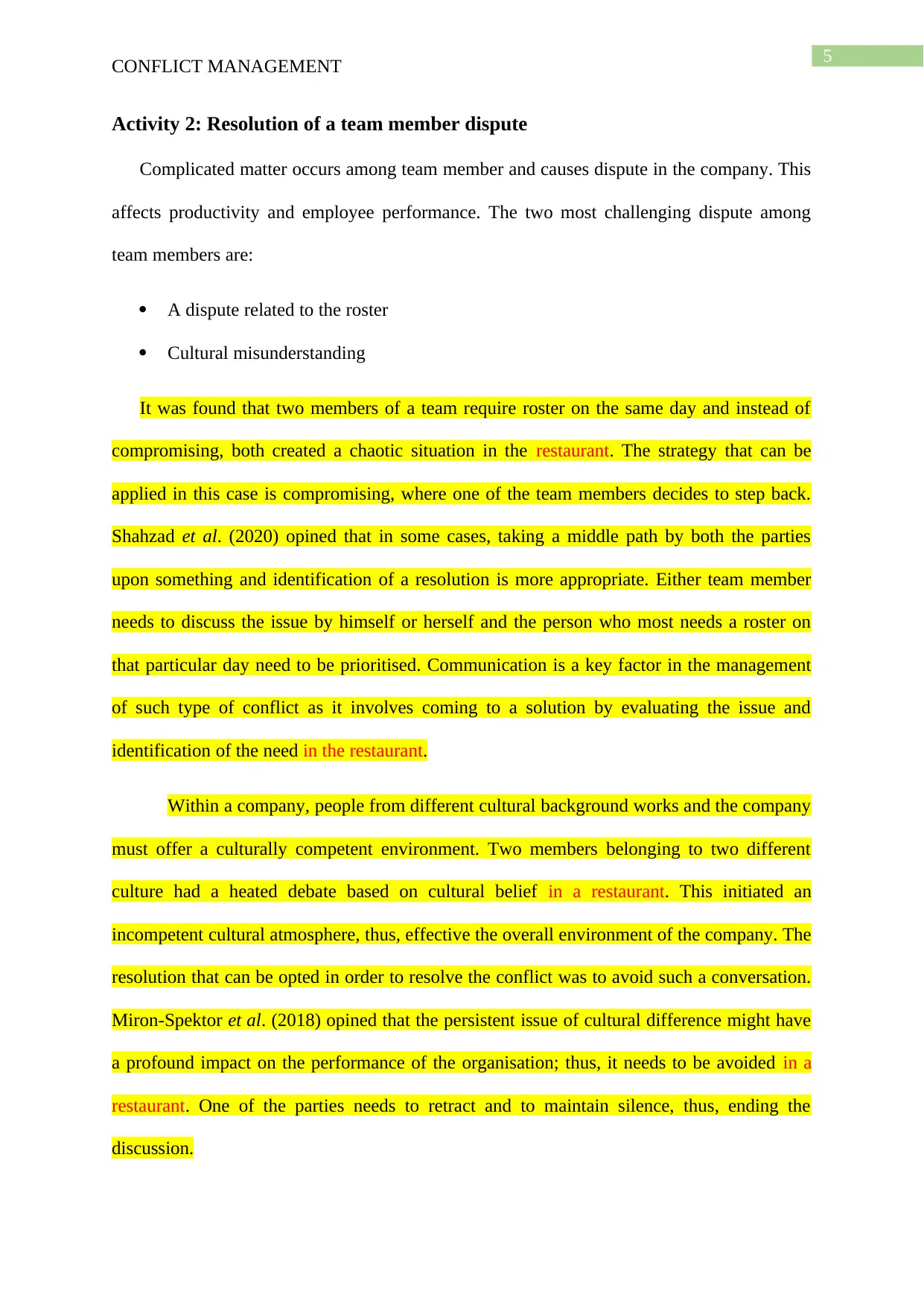
5
CONFLICT MANAGEMENT
Activity 2: Resolution of a team member dispute
Complicated matter occurs among team member and causes dispute in the company. This
affects productivity and employee performance. The two most challenging dispute among
team members are:
A dispute related to the roster
Cultural misunderstanding
It was found that two members of a team require roster on the same day and instead of
compromising, both created a chaotic situation in the restaurant. The strategy that can be
applied in this case is compromising, where one of the team members decides to step back.
Shahzad et al. (2020) opined that in some cases, taking a middle path by both the parties
upon something and identification of a resolution is more appropriate. Either team member
needs to discuss the issue by himself or herself and the person who most needs a roster on
that particular day need to be prioritised. Communication is a key factor in the management
of such type of conflict as it involves coming to a solution by evaluating the issue and
identification of the need in the restaurant.
Within a company, people from different cultural background works and the company
must offer a culturally competent environment. Two members belonging to two different
culture had a heated debate based on cultural belief in a restaurant. This initiated an
incompetent cultural atmosphere, thus, effective the overall environment of the company. The
resolution that can be opted in order to resolve the conflict was to avoid such a conversation.
Miron-Spektor et al. (2018) opined that the persistent issue of cultural difference might have
a profound impact on the performance of the organisation; thus, it needs to be avoided in a
restaurant. One of the parties needs to retract and to maintain silence, thus, ending the
discussion.
CONFLICT MANAGEMENT
Activity 2: Resolution of a team member dispute
Complicated matter occurs among team member and causes dispute in the company. This
affects productivity and employee performance. The two most challenging dispute among
team members are:
A dispute related to the roster
Cultural misunderstanding
It was found that two members of a team require roster on the same day and instead of
compromising, both created a chaotic situation in the restaurant. The strategy that can be
applied in this case is compromising, where one of the team members decides to step back.
Shahzad et al. (2020) opined that in some cases, taking a middle path by both the parties
upon something and identification of a resolution is more appropriate. Either team member
needs to discuss the issue by himself or herself and the person who most needs a roster on
that particular day need to be prioritised. Communication is a key factor in the management
of such type of conflict as it involves coming to a solution by evaluating the issue and
identification of the need in the restaurant.
Within a company, people from different cultural background works and the company
must offer a culturally competent environment. Two members belonging to two different
culture had a heated debate based on cultural belief in a restaurant. This initiated an
incompetent cultural atmosphere, thus, effective the overall environment of the company. The
resolution that can be opted in order to resolve the conflict was to avoid such a conversation.
Miron-Spektor et al. (2018) opined that the persistent issue of cultural difference might have
a profound impact on the performance of the organisation; thus, it needs to be avoided in a
restaurant. One of the parties needs to retract and to maintain silence, thus, ending the
discussion.
⊘ This is a preview!⊘
Do you want full access?
Subscribe today to unlock all pages.

Trusted by 1+ million students worldwide

6
CONFLICT MANAGEMENT
Activity 3: Appropriate actions in response to conflict situations
A varied range of threat or adverse situation occurs within a workplace that requires
an appropriate response. The threats that detrimentally affect the company are customer
refusing to leave or pacified and people involved in physical violence in a restaurant. People
have varied mind-set and react to the situation in a different manner (Martzoukou and Abdi
2017). A customer may exhibit be inflexible and do not tries to understand that an issue
occurs within a company which led to poor service in a restaurant. The strategy that can be
adopted is confronting or collaboration. A member of the company needs to take care of the
situation and tries to pacify the customer to collaborate. All the queries need to be resolved,
and his or her issue needs to be resolved with the utter most attention. On the second
scenario, if a person is using physical violence, communicating to pacify the individual needs
to be the first step for resolving the incident. If this does not work, the force needs to be
applied that would involve controlling the person.
CONFLICT MANAGEMENT
Activity 3: Appropriate actions in response to conflict situations
A varied range of threat or adverse situation occurs within a workplace that requires
an appropriate response. The threats that detrimentally affect the company are customer
refusing to leave or pacified and people involved in physical violence in a restaurant. People
have varied mind-set and react to the situation in a different manner (Martzoukou and Abdi
2017). A customer may exhibit be inflexible and do not tries to understand that an issue
occurs within a company which led to poor service in a restaurant. The strategy that can be
adopted is confronting or collaboration. A member of the company needs to take care of the
situation and tries to pacify the customer to collaborate. All the queries need to be resolved,
and his or her issue needs to be resolved with the utter most attention. On the second
scenario, if a person is using physical violence, communicating to pacify the individual needs
to be the first step for resolving the incident. If this does not work, the force needs to be
applied that would involve controlling the person.
Paraphrase This Document
Need a fresh take? Get an instant paraphrase of this document with our AI Paraphraser
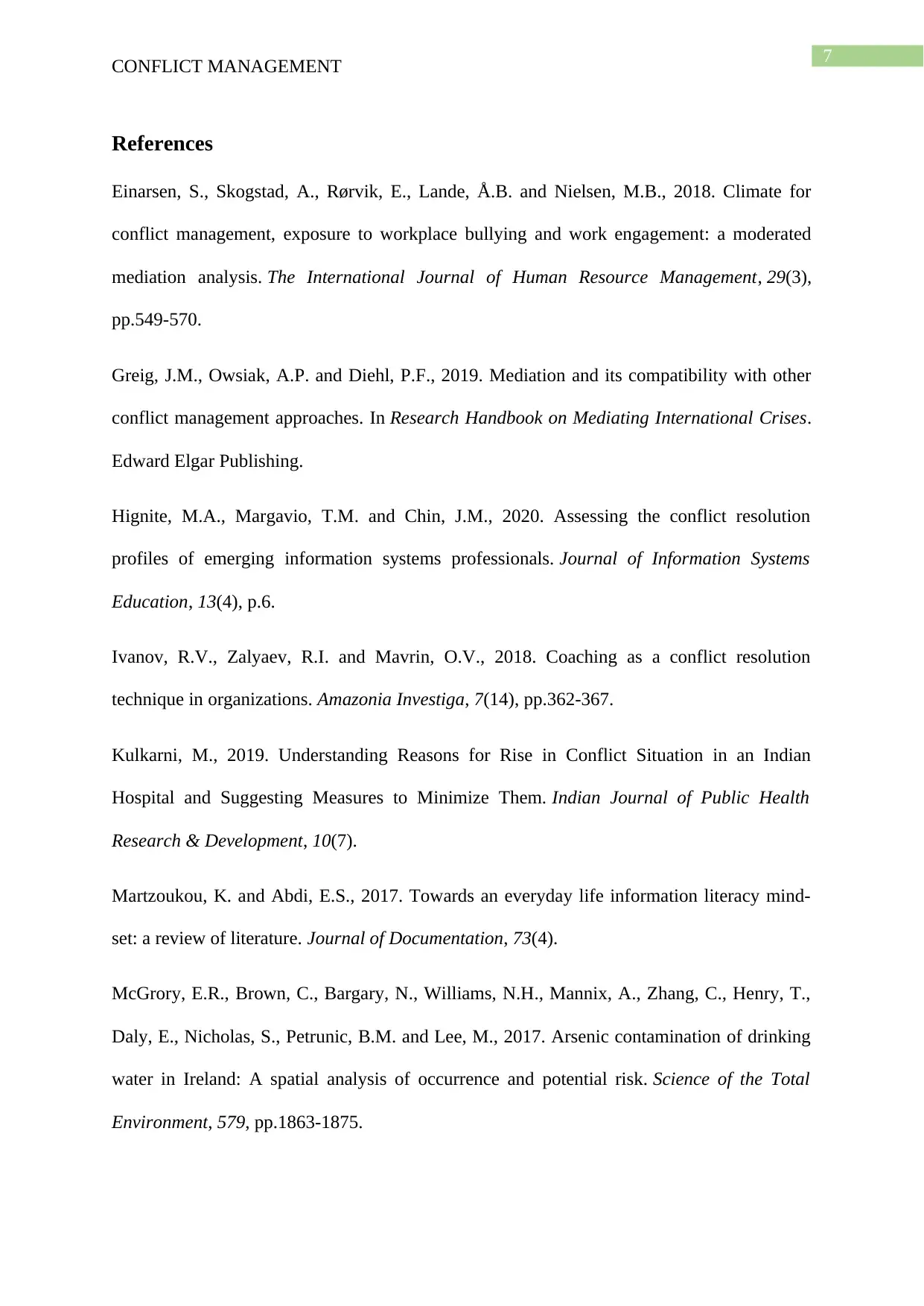
7
CONFLICT MANAGEMENT
References
Einarsen, S., Skogstad, A., Rørvik, E., Lande, Å.B. and Nielsen, M.B., 2018. Climate for
conflict management, exposure to workplace bullying and work engagement: a moderated
mediation analysis. The International Journal of Human Resource Management, 29(3),
pp.549-570.
Greig, J.M., Owsiak, A.P. and Diehl, P.F., 2019. Mediation and its compatibility with other
conflict management approaches. In Research Handbook on Mediating International Crises.
Edward Elgar Publishing.
Hignite, M.A., Margavio, T.M. and Chin, J.M., 2020. Assessing the conflict resolution
profiles of emerging information systems professionals. Journal of Information Systems
Education, 13(4), p.6.
Ivanov, R.V., Zalyaev, R.I. and Mavrin, O.V., 2018. Coaching as a conflict resolution
technique in organizations. Amazonia Investiga, 7(14), pp.362-367.
Kulkarni, M., 2019. Understanding Reasons for Rise in Conflict Situation in an Indian
Hospital and Suggesting Measures to Minimize Them. Indian Journal of Public Health
Research & Development, 10(7).
Martzoukou, K. and Abdi, E.S., 2017. Towards an everyday life information literacy mind-
set: a review of literature. Journal of Documentation, 73(4).
McGrory, E.R., Brown, C., Bargary, N., Williams, N.H., Mannix, A., Zhang, C., Henry, T.,
Daly, E., Nicholas, S., Petrunic, B.M. and Lee, M., 2017. Arsenic contamination of drinking
water in Ireland: A spatial analysis of occurrence and potential risk. Science of the Total
Environment, 579, pp.1863-1875.
CONFLICT MANAGEMENT
References
Einarsen, S., Skogstad, A., Rørvik, E., Lande, Å.B. and Nielsen, M.B., 2018. Climate for
conflict management, exposure to workplace bullying and work engagement: a moderated
mediation analysis. The International Journal of Human Resource Management, 29(3),
pp.549-570.
Greig, J.M., Owsiak, A.P. and Diehl, P.F., 2019. Mediation and its compatibility with other
conflict management approaches. In Research Handbook on Mediating International Crises.
Edward Elgar Publishing.
Hignite, M.A., Margavio, T.M. and Chin, J.M., 2020. Assessing the conflict resolution
profiles of emerging information systems professionals. Journal of Information Systems
Education, 13(4), p.6.
Ivanov, R.V., Zalyaev, R.I. and Mavrin, O.V., 2018. Coaching as a conflict resolution
technique in organizations. Amazonia Investiga, 7(14), pp.362-367.
Kulkarni, M., 2019. Understanding Reasons for Rise in Conflict Situation in an Indian
Hospital and Suggesting Measures to Minimize Them. Indian Journal of Public Health
Research & Development, 10(7).
Martzoukou, K. and Abdi, E.S., 2017. Towards an everyday life information literacy mind-
set: a review of literature. Journal of Documentation, 73(4).
McGrory, E.R., Brown, C., Bargary, N., Williams, N.H., Mannix, A., Zhang, C., Henry, T.,
Daly, E., Nicholas, S., Petrunic, B.M. and Lee, M., 2017. Arsenic contamination of drinking
water in Ireland: A spatial analysis of occurrence and potential risk. Science of the Total
Environment, 579, pp.1863-1875.

8
CONFLICT MANAGEMENT
Miron-Spektor, E., Ingram, A., Keller, J., Smith, W.K. and Lewis, M.W., 2018.
Microfoundations of organizational paradox: The problem is how we think about the
problem. Academy of Management Journal, 61(1), pp.26-45.
O'Sullivan, M., 2017. The Structural Causes of Workplace Conflict: Understanding the
Implications for the Mediation of Workplace Disputes. Bond L. Rev., 29, p.87.
Overall, N.C. and McNulty, J.K., 2017. What type of communication during conflict is
beneficial for intimate relationships?. Current opinion in psychology, 13, pp.1-5.
Rahim, M.A., 2017. Managing conflict in organizations. Routledge.
Shahzad, K., Ali, T., Kohtamäki, M. and Takala, J., 2020. Enabling roles of relationship
governance mechanisms in the choice of inter-firm conflict resolution strategies. Journal of
Business & Industrial Marketing.
Straus, M.A., 2017. Measuring intrafamily conflict and violence: The conflict tactics (CT)
scales. In Physical violence in American families (pp. 29-48). Routledge.
CONFLICT MANAGEMENT
Miron-Spektor, E., Ingram, A., Keller, J., Smith, W.K. and Lewis, M.W., 2018.
Microfoundations of organizational paradox: The problem is how we think about the
problem. Academy of Management Journal, 61(1), pp.26-45.
O'Sullivan, M., 2017. The Structural Causes of Workplace Conflict: Understanding the
Implications for the Mediation of Workplace Disputes. Bond L. Rev., 29, p.87.
Overall, N.C. and McNulty, J.K., 2017. What type of communication during conflict is
beneficial for intimate relationships?. Current opinion in psychology, 13, pp.1-5.
Rahim, M.A., 2017. Managing conflict in organizations. Routledge.
Shahzad, K., Ali, T., Kohtamäki, M. and Takala, J., 2020. Enabling roles of relationship
governance mechanisms in the choice of inter-firm conflict resolution strategies. Journal of
Business & Industrial Marketing.
Straus, M.A., 2017. Measuring intrafamily conflict and violence: The conflict tactics (CT)
scales. In Physical violence in American families (pp. 29-48). Routledge.
⊘ This is a preview!⊘
Do you want full access?
Subscribe today to unlock all pages.

Trusted by 1+ million students worldwide
1 out of 9
Related Documents
Your All-in-One AI-Powered Toolkit for Academic Success.
+13062052269
info@desklib.com
Available 24*7 on WhatsApp / Email
![[object Object]](/_next/static/media/star-bottom.7253800d.svg)
Unlock your academic potential
Copyright © 2020–2025 A2Z Services. All Rights Reserved. Developed and managed by ZUCOL.





